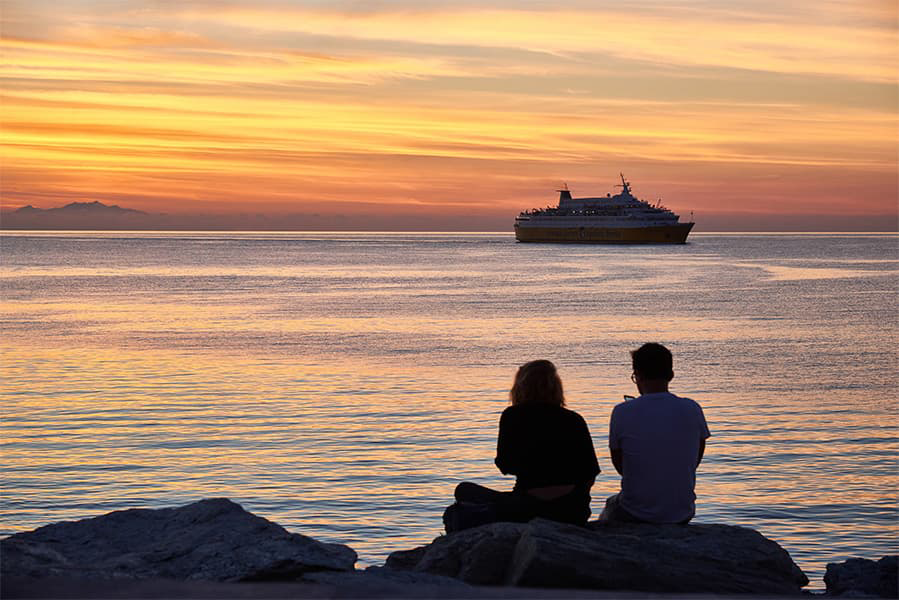Split – Korcula
Ferry to Korcula Island
Split – Korcula
Ferry to Korcula Island

Depending on the season their are usually 3 daily and 24 weekly sailings between Split and Korcula. 3 ferry operators provide the ferries from Split to Korcula, TP Line, Krilo Kapetan Luka & Jadrolinija. Split Korcula ferries take around 3 hours. The ferry costs between $65.10 and $432.94, depending on ticket details. Prices exclude any service fees. Ferry timetables change seasonally, use our Deal Finder to get live pricing and availability for ferries from Split to Korcula.
The earliest Split Korcula ferry typically departs Split at about 08:00 and the last ferry usually leaves at 16:00.
Ferries from Split to Korcula sail in around 3 hours. The fastest ferry is approximately 2 hours 20 minutes. Ferry duration can vary by ferry provider and can be impacted by weather conditions.
There is 24 weekly sailings from Split to Korcula provided by TP Line, Krilo Kapetan Luka & Jadrolinija. Timetables can change from season to season.
TP Line provide 13 sailings weekly. Krilo Kapetan Luka provide 9 sailings weekly. Jadrolinija provide 7 sailings weekly.
The price of a ferry from Split to Korcula typically range between $65.10* and $432.94*. On average the Split Korcula ferry is $191.56*. The cheapest Split Korcula ferry prices start from $65.10*. The average price for a foot passenger is $191.56*.
Pricing will vary depending on number of passengers, vehicle type, route and sailing times. Pricing is taken from searches over last 30 days and exclusive of service fees, last updated 1 April 2025.
The distance between Split to Korcula is approximately 60 miles (96km) or 52 nautical miles.
Unfortunately, cars are not allowed to travel on ferries between Split and Korcula.
TP Line, Krilo Kapetan Luka & Jadrolinija allow foot passengers on Split Korcula ferries.
Currently, are not permitted to board ferries from Split to Korcula.
More routes than anyone else.

Compare fares, times & routes in one place.
Change plans easily with flexi tickets.

Book e-tickets & manage trips in-app.
Live ship tracking & real-time updates.

Top-rated customer support when you need it.
The Croatian city of Split is Croatia's second largest city and is located in the Dalmatia region of the country. It lies on the eastern shore of the Adriatic Sea and is spread across a central peninsular. The city is an important transport hub, with many connections to the islands in the Adriatic Sea and to the Apennine Peninsular, and is also a popular tourist destination. The city can trace its history back to the 4th century BC, when it was a Greek colony of Aspalathos. Modern day Split is a lively city with many sights to keep tourists busy including the UNESCO World Heritage Site that is the Diocletian's Palace is one of the world's most impressive Roman monuments. Located within the city's old walls there are many bars, restaurants, cafes and shops that will cater for everything tourists would need. The mountains behind the city provide a lovely backdrop to Split and provide a stark contrast to the blue waters of the Adriatic.
Ferries operating from the city's port depart to Ancona, Pescara, Rijeka , Korcula, Dubrovnik and Mljet.
The Croatian island of Korcula is one of the greenest islands in the Adriatic sea and is also one of the most popular destinations in Croatia. The island's name was originally Korkyra Melaina (Black Corfu) and was given to it by the Greeks who named many of the Croatian islands. The name was perhaps given to the island in reference to its densely wooded terrain. The island has a rich cultural and artistic heritage and is also a nature lover's paradise with many tucked away beaches and coves, uninhabited islands and stunning views. The island's main town is also named Korcula and is a typical medieval walled Dalmatian city, with its round towers and red roofed houses.
The town's Old Town is a walled medieval city that is situated on an oval-shaped piece of land that sticks out into the Peljesac Channel. The Old Town itself is characterised by narrow streets that all stem of the town's main street. The fish bone shape was used in Korcula Old Town design to reduce effects of wind and sun and to provide its inhabitants with sheltered and comfortable accommodation. The architecture in the Old Town is mainly influenced by Venetian Renaissance, although there are also some fine examples of 1930's architecture.